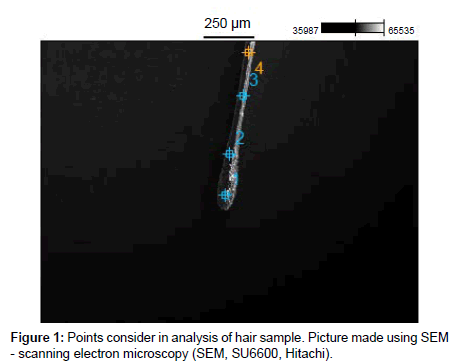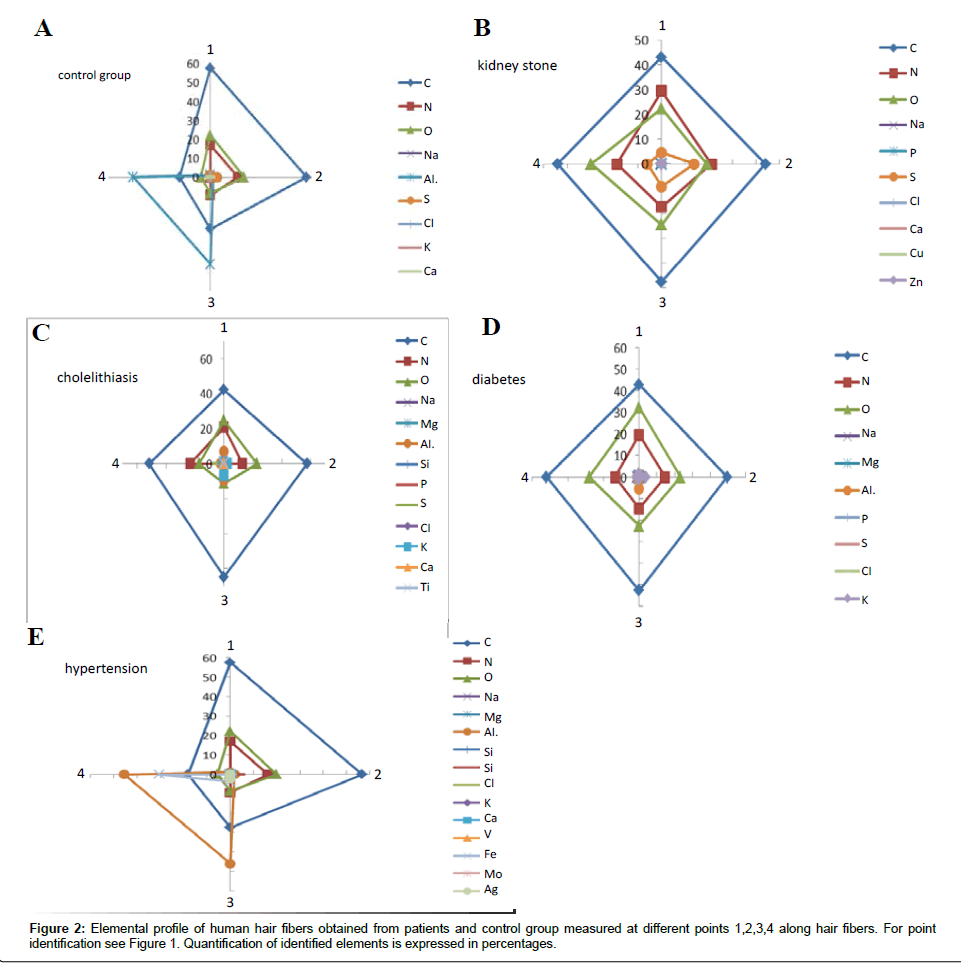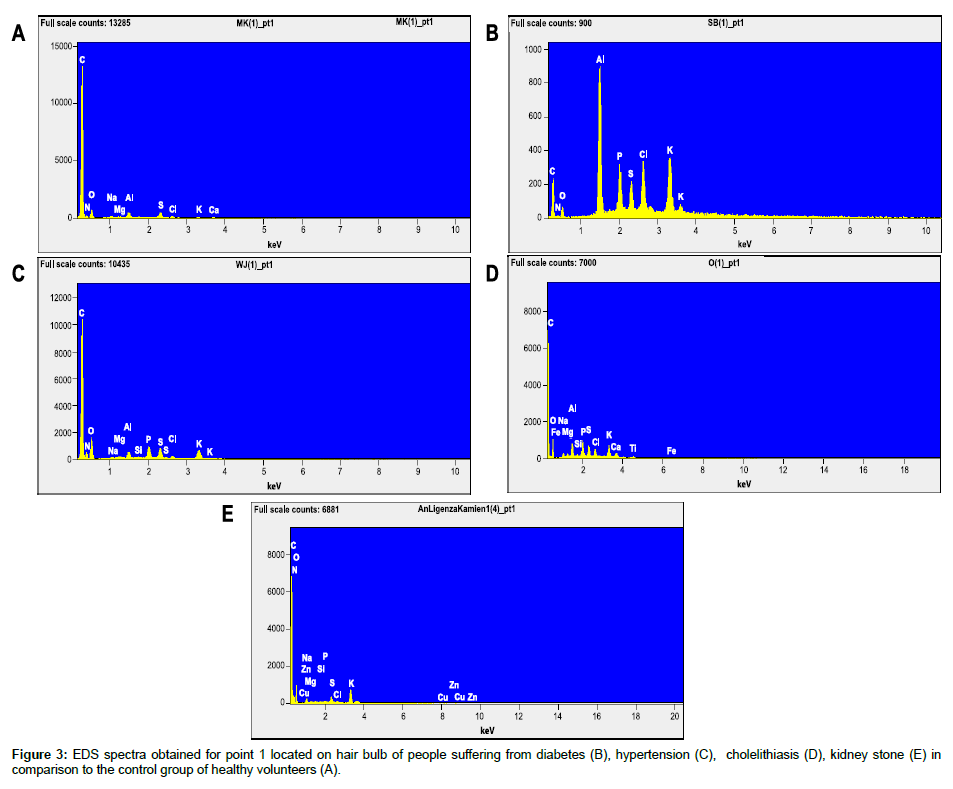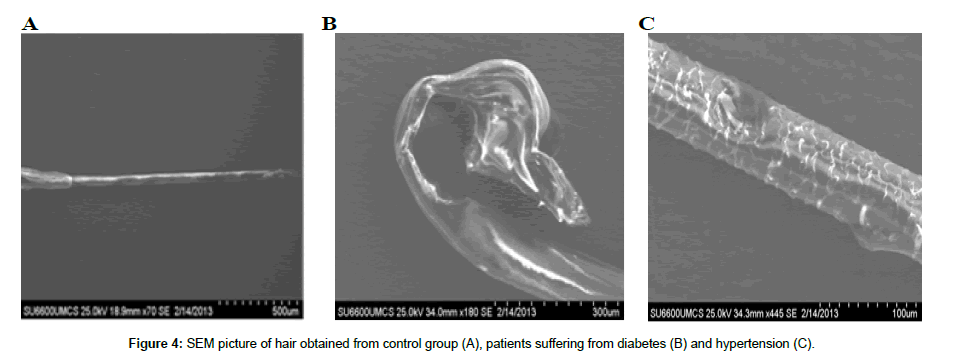Research Article Open Access
Examination of the Elemental Composition of Hair in Cholelithiasis, Kidney Stone, Hypertension and Diabetes by Scanning Electron Microscopy and Energy Dispersive Spectrometry SEM/E
Blicharska (Grushka) El1, Flieger J1*, Huber M2 and Kocjan R11Department of Analytical Chemistry, Medical University of Lublin, Poland
2Faculty of Earth Sciences and Spatial Management, Maria Curie Sklodowska University, Poland
- *Corresponding Author:
- Jolanta Flieger
Department of Analytical Chemistry,Medical University
Chodzki 4a, 20-093 Lublin, Poland
Tel: +48 81535-7350
E-mail: j.flieger@umlub.pl
Received date: September 09, 2014; Accepted date: September 25, 2014; Published date: September 29, 2014
Citation: Blicharska (Grushka) El, Flieger J, Huber M, Kocjan R (2014) Examination of the Elemental Composition of Hair in Cholelithiasis, Kidney Stone, Hypertension and Diabetes by Scanning Electron Microscopy and Energy Dispersive Spectrometry SEM/EDS. J Anal Bioanal Tech 5:207 doi: 10.4172/2155-9872.1000207
Copyright: © 2014 Blicharska (Grushka) El, et al. This is an open-access article distributed under the terms of the Creative Commons Attribution License, which permits unrestricted use, distribution, and reproduction in any medium, provided the original author and source are credited.
Visit for more related articles at Journal of Analytical & Bioanalytical Techniques
Abstract
The aim of this paper was to find some connections between elemental composition of human hair and such illnesses as kidney stone, cholelithiasis, hypertension and diabetes to assess whether hair could be a reliable marker of the above mentioned health problems. The elements were identified by Scanning Electron Microscopy and Energy Dispersive Spectrometry SEM/EDS. Elemental profiles were determined in hair from 43 patients and 32 controls. The hair samples were at the anagen phase. Results indicated the content variation along the entire length of the hair in the bulb through the root to the hair follicle and the shaft. Measurements were made at these anatomical regions. Special attention was devoted to the bulb part for which characteristic EDS spectra were illustrated for the examined illnesses.
Keywords
Human hair; Cholelithiasis; Kidney stone; Hypertension; Diabetes; Scanning electron microscopy; Energy dispersive spectrometry
Introduction
During the past few decades, trace element analysis in hair samples has been the subject of numerous environmental investigations monitoring exposure to heavy metals. Since the sixties of the twentieth century, many research programs have analyzed the metal content in human hair in order to demonstrate the negative impact of environmental pollution [1-4]. The results of these investigations clearly demonstrate the significance of hair analyses as indicator of abnormal intake/absorption of trace elements [5].
Undoubtedly, hair element concentration reflects both geochemical, nutritional, conditions and supplementation factors [6,7] but also correlates with various diseases revealing serious longterm metabolic changes. In literature, a number of papers describing the quantification of the inorganic constituents of human hair can be found, where relations between mineral composition of human hair and common illnesses are recognized. Samples of human hair appear to be an effective metal-concentrator, and their bioassay can be highly informative in diagnostic medicine. For example, blood pressure levels were assessed in combination with concentration of Fe, Ca, Mg, Zn, Cu, Na, K [8]. The relations between mineral composition of human hair and common illnesses such as infections of the respiratory system, asthma, vertigo, migraine, nervousness, hair loss, dandruff, brittle fingernails and white spots on fingernails have been found [9]. Metal content of hair was also studied in Parkinson’s disease, schizophrenia, epilepsy, autism [10,11] and Down syndrome [12]. High hair concentrations of heavy metals as: lead, cadmium, mercury and arsenic were found in children with mental retardation, learning disabilities, dyslexia and lower I.Q by Wright et al. [13]. Another study showed that the average cadmium concentration was high in scalp hair of lung cancer patients at different stages compared to controls [14].
In turn, diabetic patients showed the mean levels of zinc and manganese, significantly lower level of chromium whereas copper and iron were higher in comparison to a control group [15]. The elemental hair anomalies can be used also for the detection of disturbances in calcium/bone metabolism. High magnesium content was proved to be associated with higher bone mineral density [16-18].
In the early nineties, some positive correlation between element levels in hair and hypertension, and diabetes was found [19-21]. Some authors conclude that heavy metals, especially mercury and cadmium, should be evaluated in patients with hypertension, cardiovascular heart disease, or other vascular diseases [22].
The mineral content of human hair fibers is generally very low (less than 1%), covering such elements as: Ca, Mg, Sr, B, Al, Na, K, Zn, Cu, Mn, Fe, Ag, Au, Hg, As, Pb, Sb, Ti, W, V, Mo, I, P, and Se. That is why hair analysis requires very sensitive instrumental methods.
The mineral content of hair is usually determined by multielemental analysis using different spectroscopic, electrochemical and chromatographic techniques. The oldest ones - spectrophotometry and voltamperometry appear not to be sensitive enough as for nowadays and too complicated from the chemical point of view. The most common methods achieving current validation requirements are: atomic absorption spectrometry (AAS) and atomic fluorescence spectrometry (AFS); both can be coupled with hydride generation (HG). They are statistically significant, regarding precision, accuracy, reliability, and detection limits. Moreover, these methods are characterized by high speed and simplicity of analytical procedure, which is not insignificant. A method mostly recommended for establishing reference ranges of elements in human scalp hair is methodology of dynamic reaction cell inductively coupled plasma mass spectrometry (DRC ICP-MS), detecting elements at ppt concentration level.
Human hair, as sample with complex matrix containing cellular components, requires additional processing digestion steps before measuring analytical signals of elements by instrumental method. Mineralization in a micro-wave system is often applied for this purpose. However, improvements in instrumentations (inductively coupled plasma-mass spectrometry) and microwave digestion resulted in satisfactory precision and accuracy of quantification, and lowering detection limits; reference ranges for metal content in human hair established by this analytical procedure are very wide. That is why they are rarely used in clinical practice for diagnostic purposes.
In this paper, human scalp hair samples were analyzed for trace metals by scanning electron microscopy and energy dispersive spectrometry SEM/EDS. Scanning electron microscopy/energy dispersive X-ray spectrometry is elemental microanalysis method capable of identifying and quantifying elements which is widely applied in geological studies. To our knowledge this is the first time when SEM/EDS is used for elemental analysis in hair. Applied methodology allowed examining the distribution of metals along each strand of hair. Besides that, SEM/EDS in contrast to procedures described above for elemental analysis of hair does not require mineralization steps. Owing to this, element distribution was determined quantitatively in hair bulb, which is a structure of actively growing cells; the root which refers to the structures of the hair follicle in the dermal layer, and the hair shaft which is the part above the scalp which exhibits no biochemical activity and is considered “dead”. Special attention was paid to the analysis of hair bulbs - biochemically active zones located in the epidermal part which are devoid of external pollution.
The objective of this study is to demonstrate the distribution of metals along each strand as it changes in different diseases. The obtained results clearly demonstrate that measuring of chosen elements in hair can be diagnostically useful and can be treated as some kind of fingerprint characteristics for certain disease entities.
Experimental
Sampling and preparation
Hair samples were collected from healthy volunteers, students of Medical University of Lublin (control group covers 32 subjects) and patients of Independent Public Teaching Hospital No 4 in Lublin (43 subjects) suffering from cholelithiasis, kidney stone, hypertension and diabetes. Written consent was obtained from the volunteers prior to the trial, approved by the local ethics committee.
Participants hair (5 cm long) was obtained from the nape of the neck after four consecutive washings by surgical scissors made from stainless steel. The hair samples were stored in a paper envelope and were analysed without additional washing steps.
Analytical methods
Chemical analyses of human hair were executed by scanning electron microscopy (SEM, SU6600, Hitachi) coupled with an EDS, EBDS apparatus (Thermo), CL with UV-VIS spectrometer (Horiba).
Morphology of human hair was determined by the optical microscope with a polarizer filter (Leica DM 2500P).
The analyses were carried out in certified Electron Microscopy Laboratory in Department of Geology and Lithosphere Conservation, Faculty of Earth Sciences and Spatial Management, Maria Curie- Sklodowska University.
In this paper only statistically significant results with p < 0.05 are presented.
Results and Discussion
Energy-dispersive X-ray spectroscopy (EDS) is an analytical technique used for chemical characterization of a sample. To stimulate the emission of characteristic X-rays from a specimen, a high-energy beam of charged particles is focused onto the sample. The difference in energy between the higher-energy shell and the lower energy shell may be released in the form of an X-ray. The energy of the X-rays emitted is measured by an energy-dispersive spectrometer. This energy is characteristic and allows measuring the elemental composition of the sample.
During our study, we collected EDS spectra of different points (Figure 1) located along hair fibers and quantification of quantified identified elements.
Despite the numerous trials to find some characteristic changes in elemental composition, or ratios of different elements to each other we did not notice any rational relation between results of our measurements and particular disease incidence.
Analyzing elemental profile along hair fiber from the bulb through the root to the hair follicle and the shaft, significant changes can be found though. Figure 2 presents fluctuation in elemental composition measured at four points located on the hair fiber obtained from patients suffering from the studied illnesses.
These graphical representations of hair fibers composition at different points allow comparing only main elements present at meaningful content. These graphs reflect additionally relation between them, proportions at which they can be found at different points along the fibers. Considering representative curves obtained for control group and groups of patients suffer from hypertension, diabetes, kidney stone and cholelithiasis, we can conclude that composition of healthy subjects reflects the following order: carbon >> oxygen = nitrogen >> sulfur. At the shaft part, aluminum appeared as a significant component of the hair. This element is one of the four toxic elements (aluminium, mercury, lead and cadmium) common in our society, responsible for potential health problems such as, among others, Alzheimer’s disease, Parkinson’s disease, memory loss, mental confusion, and so on. Definitely such high aluminium hair levels reflect exposure to this element. Hair is easily contaminated with aluminium from environment, for instance - the washing water. If the control group were to be exposed to other sources of aluminum including for instance: antiperspirant or dietary components, it would be present in all measured points.
Hair of patients suffering from diabetes and kidney stone showed regular distribution of main elements along the fibres whereas hypertension sufferers possessed the dead hair part rich with trace amount of aluminium, vanadium, iron, molybdenum and silver. Although, cholelithiasis and kidney stone differ in the proportion of elements they maintain this distribution along the entire length of the hair. It is common knowledge that the ethiology of these diseases is caused by a solid concretion or crystal aggregation formed in the kidneys and the gallbladder, respectively and is linked to the imbalances in levels of elements coming mainly from dietary minerals.
Analyzing all data in a form of EDS spectra from different points on hair, we noticed that the point number 1 appears to be the crucial one. This point is located in the hair bulb. This structure possesses biochemical activity, reflecting current condition of the human organism but also has no contact with the skin surface so it is not exposed to the environment. That is why we need ‘not bower the preparation of the hair samples for testing’ – one of a major controversy surrounding hair mineral analysis [23]. Figure 3 presents comparison of EDS spectra characteristic of cholelithiasis, kidney stone, hypertension, diabetes and control coming from healthy volunteers.
Analyzing EDS spectra for this point we obtained characteristic images differing in specific disease entities. These pictures can be used in the diagnosis of these diseases as the “fingerprints”. The method is simple and requires no sample preparation. The other advantage of this method is the possibility of a direct measurement.
Control groups are characterized by small number of detected elements usually lower than 10 with a dominating carbon content (Figure 3A). At point 1 on hair bulb the following elements are identified: carbon, nitrogen, oxygen, sodium, aluminum, sulfur, chorine and calcium.
EDS spectrum characteristic of hypertension possesses dominating carbon content and poor content of several other elements detected between 1 and 4 keV such as nitrogen, oxygen, sodium, magnesium, aluminum, silicon, phosphorous, sulfur, chlorine and potassium (Figure 3B).
EDS fingerprint characteristics of diabetes possesses a few elements only usually lower than 10 covering carbon, nitrogen, oxygen, aluminum, phosphorous, sulfur, chlorine and potassium but dominating part is recorded between 1.5-3.5 keV (Figure 3C).
In turn, it was found that the hair bulb of the individuals suffering from cholelithiasis and kidney stone has the increased level of elements detected in the range of 1-4 keV in comparison to the hair of healthy individuals. Additionally, some elements were detected between 4-8 keV, such as iron and titanium in the hair of those ones suffering from cholelithiasis (Figure 3D) and above 8 keV testifying to the presence of zinc and copper for kidney stone patients (Figure 3E).
Morphological assessment of the hair of people suffering from diabetes and hypertension cholelithiasis and kidney stone was performed using scanning electron microscopy (SEM). Most of hair in the anagen phase was normal both in healthy subjects and patients however, in case of hypertension visible deformation was observed in the shaft and in the case of diabetic patients, in the bulb region (Figure 4).
Conclusion
This paper presents application of SEM/EDS for analysis of human hair. It was proved that elemental profile changes along the hair fibers. Focusing on the most biochemical active hair part – the bulb, characteristic EDS spectra were presented for the following diseases: kidney stone, cholelithiasis, hypertension and diabetes. They can be thought of as specific “fingerprints” useful for diagnosis. Moreover, morphological assessment of the hair was performed. In case of elemental and morphological analyses observed changes were always compared to the control group. SEM/EDS enabling the bulb examination can be used as an alternative method in comparison to atomic absorption spectrometry (ASA) routinely applied for this purpose. This method however requires digestion steps and preparation of sample to remove all possible contaminations from the surface. Moreover the standard elemental analysis of hair (Hair Tissue Mineral Analysis - HTMA) does not consider differences in morphological regions of hair which differs one with each other in agreement with elemental composition, which was actually proved.
References
- Ryabukhin TS (1980) International Coordinated Program on Activation Analysis of Trace Element Pollutants in Human Hair. In: Brown AC, Crounse RG, Hair, Trace Elements, and Human Illness. Praeger Publications, New York 1-71.
- Gilbert RI (1980) Trace Elements in Human Hair and Bone. In: Brown AC, Crounse RG, Hair, Trace Elements and Human Illness. Praeger Publications, New York 35-44.
- Afridi HI, Kazi TG, Jamali MK, Kazi GH, Arain MB, et al. (2006) Evaluation of toxic metals in biological samples (scalp hair, blood and urine) of steel mill workers by electrothermal atomic absorption spectrometry. Toxicol Ind Health 22: 381-393.
- Black AP, Knight R, Batty J, Haswell SJ, Lindow SW (2002) An analysis of maternal and fetal hair lead levels. BJOG 109: 1295-1297.
- Spallholz JE, Boylan LM, Palace V, Chen J, Smith L, et al. (2005) Arsenic and selenium in human hair: a comparison of five countries with and without arsenicosis. Biol Trace Elem Res 106: 133-144.
- Contiero E, Folin M (1994) Trace elements nutritional status. Use of hair as a diagnostic tool. Biol Trace Elem Res 40: 151-160.
- Wang CT, Chang WT, Zeng WF, Lin CH (2005) Concentrations of calcium, copper, iron, magnesium, potassium, sodium and zinc in adult female hair with different body mass indexes in Taiwan. Clin Chem Lab Med 43: 389-393.
- Rebacz-Maron E, Baranowska-Bosiacka I, Gutowska I, Chlubek D (2013) Blood pressure and levels of Fe, Ca, Mg, Zn, Cu, Na and K in the hair of young Bantu men from Tanzania. Biol Trace Elem Res 151: 350-359.
- Michalak I, Chojnacka K, Saeid A (2012) Relation between mineral composition of human hair and common Illnesses. Chin Sci Bull 57: 3460-3465.
- Forte G, Alimonti A, Violante N, Di Gregorio M, Senofonte O, et al. (2005) Calcium, copper, iron, magnesium, silicon and zinc content of hair in Parkinson's disease. J Trace Elem Med Biol 19: 195-201.
- Johnson S (2001) Micronutrient accumulation and depletion in schizophrenia, epilepsy, autism and Parkinson's disease? Med Hypotheses 56: 641-645.
- Ilhan A, Uz E, Kali S, Var A, Akyol O (1999) Serum and hair trace element levels in patients with epilepsy and healthy subjects: does the antiepileptic therapy affect the element concentrations of hair? Eur J Neurol 6: 705-709.
- Wright RO, Baccarelli A (2007) Metals and neurotoxicology. J Nutr 137: 2809-2813.
- Kazi TG, Memon AR, Afridi HI, Jamali MK, Arain MB, et al. (2008) Determination of cadmium in whole blood and scalp hair samples of Pakistani male lung cancer patients by electrothermal atomic absorption spectrometer. Sci Total Environ 389: 270-276.
- Kazi TG, Afridi HI, Kazi N, Jamali MK, Arain MB, et al. (2008) Copper, chromium, manganese, iron, nickel, and zinc levels in biological samples of diabetes mellitus patients. Biol Trace Elem Res 122: 1-18.
- Song CH, Barrett-Connor E, Chung JH, Kim SH, Kim KS (2007) Associations of calcium and magnesium in serum and hair with bone mineral density in premenopausal women. Biol Trace Elem Res 118: 1-9.
- Dastych M, Cienciala J, Krbec M (2008) Changes of selenium, copper, and zinc content in hair and serum of patients with idiopathic scoliosis. J Orthop Res 26: 1279-1282.
- Miekeley N, de Fortes Carvalho LM, Porto da Silveira CL, Lima MB (2001) Elemental anomalies in hair as indicators of endocrinologic pathologies and deficiencies in calcium and bone metabolism. J Trace Elem Med Biol 15: 46-55.
- Sukumar A, Subramanian R (1992) Elements in hair and nails of urban residents of New Delhi. CHD, hypertensive, and diabetic cases. Biol Trace Elem Res 34: 89-97.
- Stupar J, Vrtovec M, Dolinsek F (2007) Longitudinal hair chromium profiles of elderly subjects with normal glucose tolerance and type 2 diabetes mellitus. Metabolism 56: 94-104.
- Huang H, Hu W, Han Z, Ye H (2005) Hybrid Progressive Algorithm to Recognize Type II Diabetic Based on Hair Mineral Element Contents. Conf Proc IEEE Eng Med Biol Soc 5: 4716-4718.
- Houston MC (2007) The role of mercury and cadmium heavy metals in vascular disease, hypertension, coronary heart disease, and myocardial infarction. Altern Ther Health Med 13: S128-133.
- Wilson L (2012) Hair analysis controversy. The Center for Development.
Relevant Topics
Recommended Journals
Article Tools
Article Usage
- Total views: 15966
- [From(publication date):
September-2014 - Apr 03, 2025] - Breakdown by view type
- HTML page views : 11296
- PDF downloads : 4670




